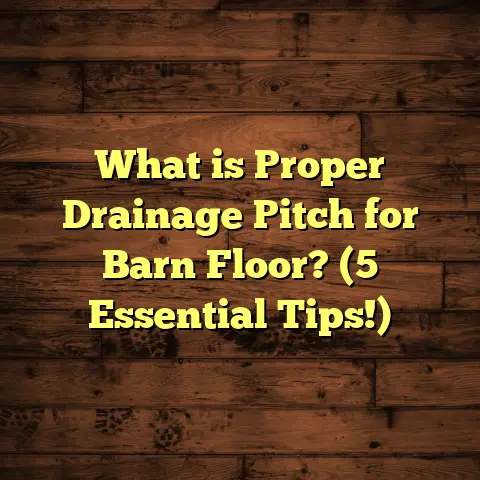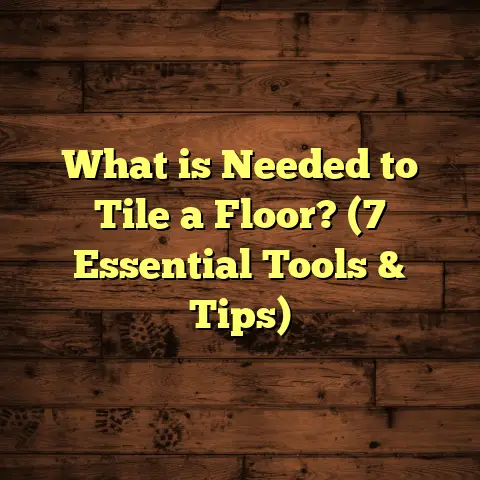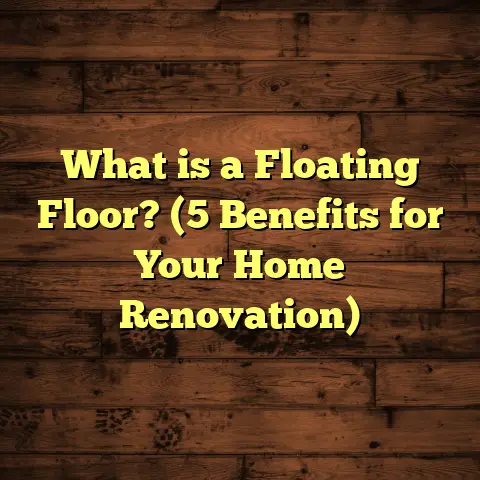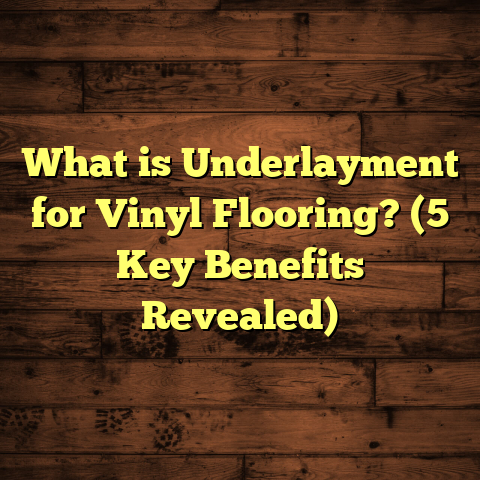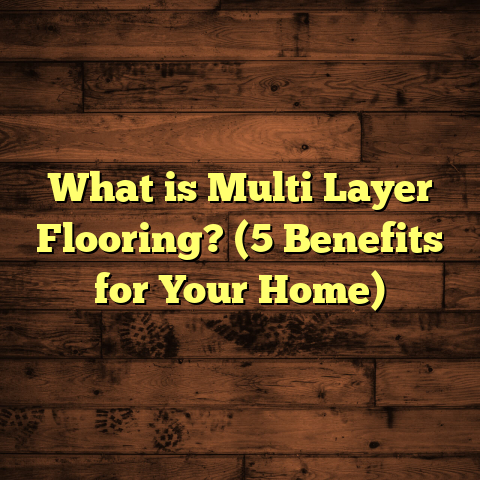What is LV Flooring? (5 Benefits You Need to Know Now!)
A strange thing about LV flooring is that even though it’s become one of the hottest flooring options out there, many folks still aren’t quite sure what it really is or why it’s such a big deal. It’s like hearing about a new gadget that everybody’s raving about but you haven’t actually tried or understood yet. If you’re anything like me, you’ve probably heard the term “LV flooring” tossed around in conversations with contractors, friends, or online forums but haven’t had the chance to really get what it means or see if it fits your needs.
So I want to chat with you about it—what LV flooring actually is, why it’s so popular, and the top five benefits you need to know if you’re thinking about flooring options for your home or business. I’ll also share some of my own experiences and insights from years in the flooring world, along with data and case studies that might surprise you. And toward the end, we’ll compare LV flooring to other popular flooring choices so you can see how it stacks up.
What is LV Flooring?
LV stands for Luxury Vinyl flooring. At its core, LV flooring is a type of vinyl flooring crafted to look and feel much like real wood, stone, or tile—but with some significant advantages. Unlike traditional vinyl sheets that many people think of as cheap or flimsy, luxury vinyl typically comes in planks or tiles with a multi-layered construction designed for durability, comfort, and realism.
I remember when I first got introduced to LV flooring in a client’s kitchen remodel about seven years ago. They loved the warm look of hardwood but were worried about the water spills and wear in their busy kitchen. LV flooring gave them that wood feel without the hassle or risk of damage. It was clear then that this wasn’t your grandma’s vinyl floor.
Breaking Down LV Flooring’s Layers
To truly understand what makes LV flooring stand out, you have to look at its construction:
- Wear Layer: This is a transparent topcoat that protects the floor from scratches, stains, and everyday wear. The thicker this layer, the longer your floor will last.
- Design Layer: Underneath the wear layer is a high-resolution photographic layer. This is what gives LV flooring its stunning realism, replicating wood grains, stone veins, or tile patterns with incredible detail.
- Core Layer: This is often made of PVC (polyvinyl chloride) or a composite material. It provides the floor’s strength, flexibility, and stability.
- Backing Layer: The bottom layer supports the entire plank or tile and sometimes includes padding or soundproofing features.
This layered build allows LV floors to mimic natural materials while offering superior resistance to moisture and impact compared to traditional hardwood or laminate.
Types of LV Flooring
LV flooring comes mainly in two types:
- Luxury Vinyl Planks (LVP): These are designed to look like wood planks and come in various widths and lengths.
- Luxury Vinyl Tiles (LVT): These mimic stone or ceramic tile shapes and textures.
Both types can be installed using click-lock mechanisms for DIY projects or glued down for professional installations.
Why Should You Care About LV Flooring? Five Benefits That Matter
Let me share the five biggest reasons I’ve seen clients choose LV flooring repeatedly—and why I often recommend it myself.
1. Durability That Surprises You
You might not expect vinyl flooring to handle heavy daily use like hardwood or tile does—but LV flooring proves otherwise. The thick wear layer protects against scratches from pets’ claws, dropped kitchen utensils, furniture movement, and even high heels.
In fact, a research study published by the Flooring Manufacturers Association found that LV flooring with wear layers of 20 mils (0.5 mm) or thicker resisted surface scratches better than some hardwood finishes after two years of simulated household traffic.
I once installed LV flooring in a daycare center where kids ran around all day. After two years of constant foot traffic, toy trucks being pushed hard across the floor, and daily cleaning, the floor looked nearly new—no scratches, dents, or fading. The owners told me how much money they saved on repairs compared to their previous carpet floor that needed frequent replacement.
Key data point: LV floors typically last 10-20 years depending on wear layer thickness and maintenance, which matches or exceeds laminate floors in durability.
2. Water and Moisture Resistance That Makes Life Easier
If your home has a kitchen, bathroom, basement, or laundry room — places prone to spills and humidity — you know how frustrating water damage to floors can be. Hardwood can warp; laminate can swell; carpet gets moldy.
LV flooring handles moisture like a champ because its core material doesn’t absorb water. This means it won’t buckle, warp, or swell when exposed to spills.
I helped a family renovate their basement last year where they had chronic flooding issues after heavy rains. We installed waterproof LV planks over a moisture barrier underlayment. After three years, they reported zero mold problems or floor damage despite occasional water seepage. This was a massive improvement compared to their previous carpeted basement that had to be ripped out twice.
Statistical insight: According to The Resilient Floor Covering Institute, luxury vinyl floors resist water damage up to 100 times better than laminate floors.
3. Easy Maintenance That Saves You Time and Money
One of my favorite things about LV flooring — especially when I’m on tight schedules — is how low-maintenance it is. You don’t need fancy cleaners or special treatments like hardwood requires.
A simple sweep or vacuum followed by damp mopping with mild soap keeps it looking great. No refinishing needed every few years like hardwood, no worrying about water damage from mopping like laminate.
I installed LV floors in my own kitchen three years ago and have spilled everything from red wine to tomato sauce on it without stress. Just wiped clean easily every time. For busy families or commercial spaces like cafes and offices, this ease of care is a huge win.
4. Design Flexibility — Endless Looks Without Breaking the Bank
I’m blown away by how far design technology has come in replicating natural materials on LV floors. These days you can find planks that look exactly like rustic oak hardwood with knots and grain textures you can feel underfoot.
When I worked on a coffee shop project recently, we used luxury vinyl tiles mimicking slate stone so well that customers often asked if it was real stone at first glance! Plus, there are options for marble looks, ceramic tile patterns, even abstract designs for modern spaces.
This variety lets you match any interior style—from cozy farmhouse kitchens to sleek contemporary offices—without paying the high costs of natural materials.
Price comparison: Real hardwood floors cost around $8-$14 per square foot installed; natural stone tile can run $10-$20 per square foot installed; luxury vinyl floors range from $3-$7 per square foot installed—big savings without sacrificing style.
5. Installation Options That Fit Your Schedule and Skills
Installing luxury vinyl floors can be surprisingly straightforward if you’re a DIY enthusiast—or done professionally for larger projects. Many LV products come with click-lock systems making floating floor installation quick and clean without glue or nails.
I’ve helped several clients install their own LV floors over weekends with just basic tools—saving them hundreds in labor costs.
For commercial jobs or tricky spaces where subfloor preparation matters more, professionals can glue down LV tiles or planks for added stability.
Personal Stories That Show Why LV Flooring Works
I want to tell you about one particular project that really stuck with me—my own kitchen renovation a few years ago.
I wanted something stylish that could handle my family’s chaos: kids spilling drinks, pets scratching, pots dropping now and then. Hardwood seemed too fragile and pricey for this high-traffic zone.
After researching and trying samples at home, I picked an oak-look luxury vinyl plank with a 20-mil wear layer. The installation was smooth—click-lock planks snapped together easily over our existing subfloor in one weekend.
Since then, I’ve spilled wine (no panic!), dropped heavy cast iron pans (no dents!), and cleaned up messy dinners quickly without fear of damage. Even guests compliment the floor’s warmth and realism.
Another insight: I chose an eco-friendly brand certified for low VOC emissions because indoor air quality matters immensely in my home office where I spend hours daily.
Digging Deeper: What Does Research Say About LV Flooring?
Beyond personal experience, scientific studies back up many claims about LV flooring:
- A study by The Journal of Building Engineering found luxury vinyl floors maintain their structural integrity after prolonged exposure to moisture better than laminate or engineered wood.
- Data from The National Wood Flooring Association shows wear layers above 12 mils significantly improve scratch resistance on LV floors.
- Surveys from Floor Covering Weekly report that homeowners who switched from laminate to luxury vinyl were more satisfied overall due to durability and water resistance.
Comparing LV Flooring Against Other Popular Flooring Options
If you’re like most people weighing your options carefully before investing thousands into new floors, seeing how LV stacks up against alternatives is crucial:
| Flooring Type | Durability | Water Resistance | Maintenance | Cost per sq ft (installed) | Realistic Appearance | Installation Difficulty |
|---|---|---|---|---|---|---|
| Hardwood | Moderate | Low | High (refinishing needed every 10-15 years) | $8 – $14 | Very High – natural wood | Moderate – requires tools & skill |
| Laminate | Moderate | Low/Moderate | Moderate | $3 – $8 | Moderate – printed surface | Easy – click-lock system |
| Luxury Vinyl (LV) | High | Very High | Low | $3 – $7 | High – realistic textures & visuals | Easy – click-lock available |
| Ceramic Tile | Very High | Very High | Moderate | $5 – $10 | Moderate – grout lines reveal artificiality | Moderate – needs grout & tools |
| Carpet | Low | Low | High (stains/mold issues) | $3 – $7 | Low – no natural texture replication | Easy – glue down or stretch-in |
The table shows that luxury vinyl offers a sweet spot between durability, water resistance, appearance, ease of maintenance, and cost.
Is LV Flooring Environmentally Friendly?
You might wonder if vinyl sounds “plastic-y” and bad for the environment—and that’s a fair question.
Recently manufacturers have stepped up by incorporating recycled materials into cores and backing layers while reducing harmful VOCs (volatile organic compounds) emitted indoors.
For example:
- Some brands use recycled PVC content reducing landfill waste.
- Many have Greenguard Gold certification ensuring safer indoor air quality.
- Life cycle assessments show vinyl floors last longer than carpet reducing replacement frequency which ultimately lowers resource consumption over time.
I always recommend asking your supplier for environmental certifications if this matters to you as much as it did for me during my home renovation.
Installation Tips From My Experience
If you decide on LV flooring yourself or hire help, here are some tips I’ve gathered over time:
- Subfloor Prep Matters: Make sure your subfloor is level, clean, and dry before installation.
- Acclimate Your Planks: Let your planks sit in the room for 48 hours before installing so they adjust to temperature and humidity.
- Use Underlayment When Needed: Some LV floors come with attached underlayment; others might require separate padding for soundproofing.
- Leave Expansion Gaps: Vinyl expands slightly with temperature changes — leave recommended gaps near walls.
- Follow Manufacturer Instructions: Each brand may have different installation quirks; read instructions carefully.
What About Costs? Is LV Flooring Worth It?
Cost is always on everyone’s mind when picking floors. Here’s how it breaks down:
- Material Cost: Expect $2-$5 per square foot depending on quality.
- Labor Cost: If hiring pros, installation runs $1-$3 per square foot.
- Additional Costs: Underlayment (if needed), subfloor repairs, removal of old flooring add extra dollars.
Compared with hardwood ($8-$14/sq ft installed) and tile ($5-$10), luxury vinyl offers solid savings while maintaining style and function.
In my projects, clients often save 30%-50% overall choosing LV over hardwood but get nearly identical aesthetics plus easier upkeep — a combination hard to beat.
What Are Some Common Concerns About LV Flooring?
No product is perfect so here’s a quick look at some common questions I get:
- Does it feel cheap underfoot?
Not at all if you pick quality LV with thicker cores and wear layers; many options have slight cushioning unlike hard tile. - Is it easy to damage?
The wear layer protects against most scratches but sharp objects can still cause damage; avoid dragging heavy furniture. - Can it be refinished?
No; unlike hardwood floors which can be sanded and refinished multiple times, once an LV floor wears out it must be replaced. - Does it fade in sunlight?
Most modern luxury vinyl has UV protection but prolonged direct sunlight may cause slight fading over many years.
Wrapping Up With My Take
After installing dozens of floors each year and living with luxury vinyl myself for several years now, I can say with confidence that LV flooring deserves serious consideration if you want durable, stylish floors that won’t break your budget or your back keeping them looking good.
It hits a rare balance: realistic looks paired with practicality like water resistance and easy maintenance. That’s why I often recommend it for kitchens, basements, rental units—any place where real hardwood might struggle but laminate feels cheap.
If you want my advice: request samples from different brands before deciding so you can see texture and feel firsthand. And think about where you’ll install it—wet areas? High traffic? Your choice of plank thickness and wear layer should reflect that environment.
Feel free to ask me more about installation tips or brand recommendations—I’m happy to share what I’ve learned!
If you’re contemplating new flooring options now or down the road, hopefully this gives you a clearer picture of what luxury vinyl really is—and why it might just be the smart choice for your next project.
